Milwaukee, << mihl WAH kee, >> is the largest city in Wisconsin, an industrial center, and an important Great Lakes port. It lies on Lake Michigan, in southeastern Wisconsin, about 90 miles (140 kilometers) north of Chicago.
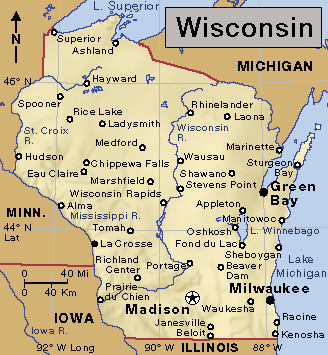
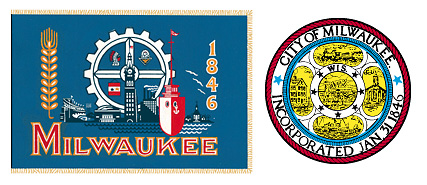
Milwaukee’s name comes from the Milwaukee River, which flows through the city. Most historians say that the river’s Algonquian name, Millioke, means good land. Others believe the name comes from a Potawatomi word that means great council place. Milwaukee is often called the Cream City because of its many old cream-colored brick buildings.
Descendants of German immigrants make up a large part of Milwaukee’s population. Business and street names, cultural events, and famous restaurants in Milwaukee are reminders of the city’s German heritage.
Solomon Juneau, a French-Canadian fur trader, settled in the Milwaukee area in 1818. He established a town on the east side of the Milwaukee River in 1833. The town later combined with neighboring villages and became Milwaukee.
Trade accounted for much of the city’s early growth. During the 1860’s, Milwaukee was one of the leading grain markets in the United States. However, by the late 1800’s, manufacturing had replaced trade as the city’s chief source of income. Today, service industries make up the largest sector of the economy.
Metropolitan Milwaukee
Milwaukee, the seat of Milwaukee County, covers about 40 percent of the county. It extends about 10 miles (16 kilometers) along the shore of Lake Michigan. The city’s metropolitan area covers four counties—Milwaukee, Ozaukee, Washington, and Waukesha. Over 25 percent of the state’s people live in this metropolitan area.
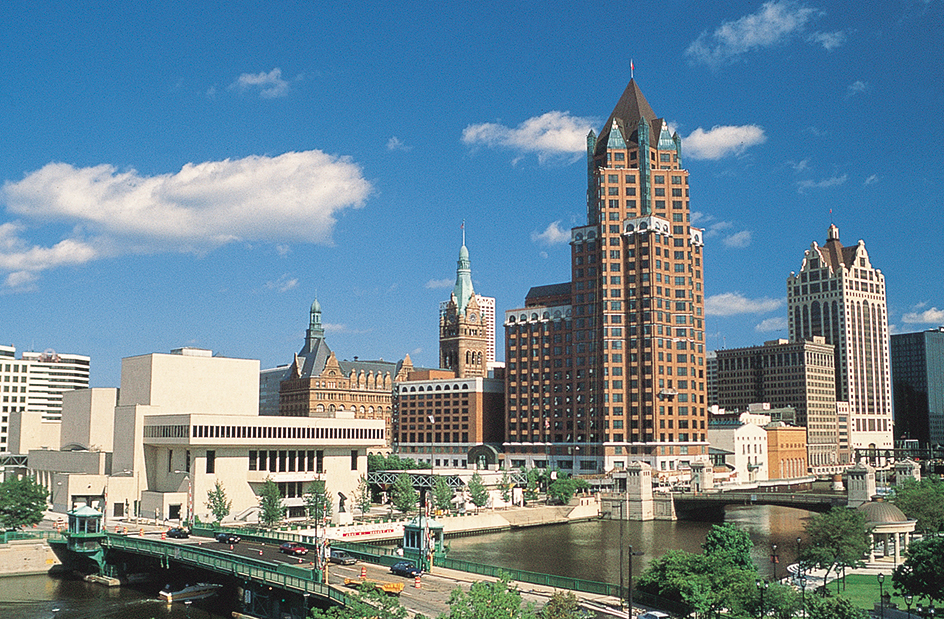
The city.
Milwaukee lies on a bluff overlooking a crescent-shaped bay of Lake Michigan. Three rivers—the Kinnickinnic, the Menomonee, and the Milwaukee—flow through the city to the bay.
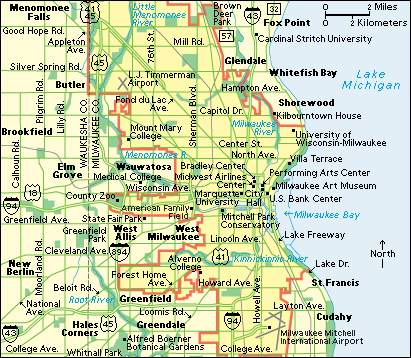
The streets of Milwaukee run in a checkerboard pattern. Many north-south streets have numbers instead of names. The Menomonee Valley divides the city into the North Side and South Side. The main business district lies north of the valley, and older residential areas and industrial districts are to the south.
Downtown Milwaukee extends west for about 2 miles (3 kilometers) from the lakefront. Banks, department stores, office buildings, restaurants, and specialty shops line Wisconsin Avenue, the city’s main street. Government buildings include City Hall on East Wells Street and the County Court House on North 9th Street.
Just north of the downtown area is the city’s biggest entertainment complex. It includes the Fiserv Forum and UW-Milwaukee Panther Arena, which host sports and other events; the Miller High Life Theatre, which presents plays and other performances; and the Wisconsin Center, which is used for conventions.
The metropolitan area.
The Milwaukee-Waukesha metropolitan area spreads over Milwaukee, Ozaukee, Washington, and Waukesha counties. A network of freeways connects downtown Milwaukee and its suburbs. Two of the largest suburbs, West Allis and Wauwatosa, lie just west of the city. Other suburbs include Cudahy, Franklin, Oak Creek, St. Francis, Shorewood, South Milwaukee, and Whitefish Bay. Large shopping centers, such as Bayshore, Brookfield Square, and Southridge, serve the suburbs.
The people
Milwaukee has long ranked among the largest Great Lakes cities. African Americans account for nearly 40 percent of Milwaukee’s population. White people make up about 35 percent. Hispanic Americans, who can be of any race, make up about 20 percent of the population.
Many Milwaukee residents have German ancestry. Numerous festivals in the Milwaukee area celebrate the city’s German heritage. People of Polish ancestry also make up a large group in the city. Other groups include people of English, Irish, Italian, or Mexican descent.
Economy
Service industries employ many people in Milwaukee and make up the largest sector of the city’s economy. These industries include wholesale and retail trade, transportation, utilities, education, and health care. Manufacturing also provides many jobs. The city ranks as a leading manufacturer of automobile parts, beer, electrical machinery, and thermostats and other electronic controls. Other products include mining machinery, parts for steel foundries, and X-ray equipment. Printing is another important industry.
The headquarters of the Northwestern Mutual Life Insurance Company are in Milwaukee. The company is one of the nation’s largest insurance firms. Milwaukee also has a growing information technology sector.
Milwaukee’s harbor handles millions of tons of cargo annually. Ships connect the city with about 100 overseas ports by way of the St. Lawrence Seaway.
Passenger trains and rail freight lines serve Milwaukee. The area also has an extensive system of expressways. The main airport is Milwaukee Mitchell International Airport. High-speed ferry service across Lake Michigan connects Milwaukee and Muskegon, Michigan. Milwaukee has one daily newspaper, the Milwaukee Journal Sentinel.
Education
A nine-member elected Board of School Directors supervises the Milwaukee public school system. The city has a number of special public schools known as charter schools. These schools operate according to the terms of special contracts called charters that give them freedom from many of the rules that apply to traditional public schools.
Milwaukee also has many parochial and other private schools. The city has a school voucher program, which it adopted in 1990. Under this program, low-income families receive a coupon called a voucher that they can use for tuition to attend private schools.
The University of Wisconsin-Milwaukee is the city’s largest university. Marquette University, a private school sponsored by the Society of Jesus (Jesuits), is the second largest university. Alverno College, Cardinal Stritch University, Concordia University Wisconsin, Mount Mary University, and Wisconsin Lutheran College are also in the area. Training for the Roman Catholic priesthood is provided at the graduate level by St. Francis de Sales Seminary, in nearby St. Francis.
Other institutions of higher learning in the Milwaukee area include the Medical College of Wisconsin, the Milwaukee Institute of Art & Design, and Milwaukee School of Engineering. The Milwaukee Area Technical College is one of the nation’s largest vocational and adult education centers.
The Milwaukee Public Library was established in 1878. Today, the library system consists of a central library downtown and branches throughout the city.
Cultural life
The arts.
The Marcus Performing Arts Center, in the downtown theater district, houses the Milwaukee Ballet, the Florentine Opera Company, and other performing arts groups. The district includes the Pabst and Riverside theaters, which provide elegant settings for stage performances. It is also the home of the Milwaukee Repertory Theater and other theater groups. Milwaukee also has a symphony orchestra and many nightclubs as well.
Museums.
The Milwaukee Art Museum displays American and European paintings and sculpture. It stands on the downtown lakefront. The American architect Eero Saarinen designed the museum’s main building. The Spanish architect Santiago Calatrava designed the building’s striking addition, which is covered by a huge sunscreen that can be raised or lowered.
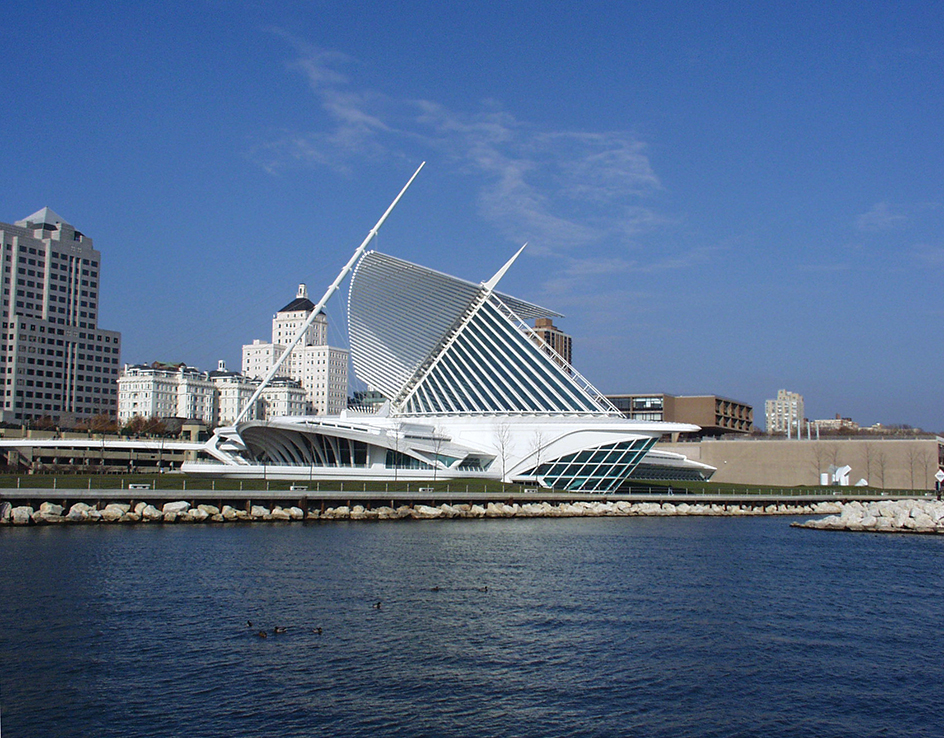
The Milwaukee Public Museum contains many natural-history exhibits. It also has a model of a Milwaukee street as it looked in the early 1900’s. The Milwaukee County Historical Center features exhibits of local history. Both museums are in the downtown area.
Recreation
Parks.
The Milwaukee County park system includes dozens of parks and parkways. The largest park in the county system, Whitnall Park, occupies 640 acres (260 hectares). The park features the beautiful Alfred Boerner Botanical Gardens, which have more than 1,000 species of flowers. A conservatory in Mitchell Park displays plants of desert, temperate, and tropical climates in their natural settings. The Milwaukee County Zoo has wide moats and glass-enclosed cages, rather than bars. Visitors may tour the zoo in a miniature train or in a rubber-tired “zoomobile.”

Sports.
The city has two major professional sports teams. They are the Milwaukee Brewers baseball team of the National League and the Milwaukee Bucks of the National Basketball Association.
Annual events and places of interest
in the Milwaukee area include:
Lakefront Festival of Art,
in early summer, features hundreds of artworks displayed on the lawns near the Milwaukee Art Museum.
Summerfest,
a celebration that takes place in late June and early July, features fireworks displays and music and stage entertainment. Ethnic and cultural festivals are held on the lakefront most weekends from June until September. 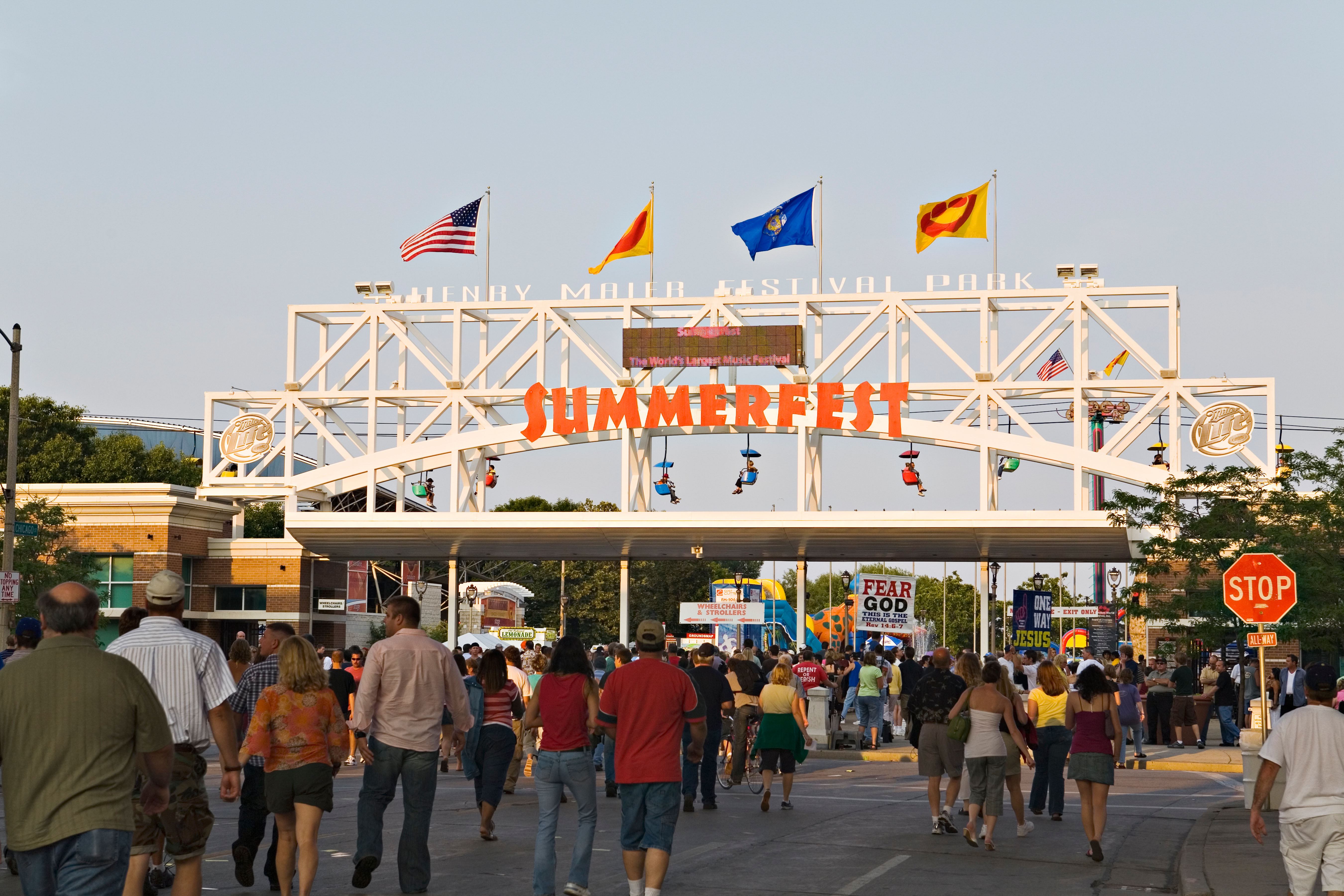
Allen-Bradley Clock Tower,
on the city’s south side, is a well-known landmark. Each side of the tower has a huge octagonal clock face. The minute hands are 20 feet (6 meters) long.
The Annunciation Greek Orthodox Church
in nearby Wauwatosa was designed by the famous American architect Frank Lloyd Wright.
St. Joan of Arc Chapel
stands on the Marquette University campus. This chapel, built in France during the 1400’s, was reconstructed on the campus in the 1960’s.
Kilbourntown House
in Estabrook Park was the home of Benjamin Church, a pioneer architect in the city. Church built the house in 1844.
State Fair Park,
in suburban West Allis, has facilities for conventions, stage entertainment, and automobile races. The Wisconsin State Fair is held at the park in August.
Government
Milwaukee has a mayor-council form of government. The voters elect the mayor to a four-year term. The mayor appoints major department heads and members of various boards and commissions. Most of the appointments are subject to approval by the council. The mayor has veto power over some council decisions and may also propose legislation.
Milwaukee is divided into 15 city council districts. The voters of each district elect one representative, called an alderman or alderwoman, to the city council, which is officially called the Common Council. The aldermen and alderwomen serve four-year terms.
Property taxes provide much of the city’s revenue. Other sources of revenue include state and federal aid.
History
Early development.
The Fox, Mascouten, and Potawatomi peoples hunted in the Milwaukee area before the first European settlers arrived. In 1674, Jacques Marquette, a French missionary, stopped at the site. Later, other missionaries and fur traders began to visit the area. One trader, Jacques Vieau, opened a trading post there in 1795. Solomon Juneau, Vieau’s clerk and son-in-law, settled in the area in 1818. In 1833, Juneau founded a town on the east side of the Milwaukee River.
During the 1830’s, many settlers came from the eastern United States. They included Byron Kilbourn of Connecticut and George H. Walker of Virginia. Kilbourn set up his own community on the west side of the Milwaukee River. Walker developed the area south of the Menomonee River. In the late 1830’s, the settlements combined to form the Village of Milwaukee. Milwaukee received a city charter in 1846, and Solomon Juneau became its first mayor. By 1847, Milwaukee’s population was about 12,000.
Beginning in the 1840’s, many Europeans settled in Milwaukee. They included many Germans, Irish, and Poles. These immigrants played an important role in the city’s cultural, economic, and political development.
Economic growth.
During the 1850’s and 1860’s, Milwaukee flourished as a commercial center. Harbor improvements and the construction of roads and railroads helped the city become a leading market for flour and wheat. After 1870, manufacturing became the city’s chief economic activity. With the growth of such industries as meat packing and tanning, Milwaukee’s population rose to more than 200,000 by 1890.
The 1900’s.
Industrialization provided a base for the Socialist movement of the late 1800’s and 1900’s. Milwaukee Socialists did little to promote public ownership of industry, a traditional goal of socialism. Instead, they fought for labor and political reforms and greater social benefits.
In 1910, Milwaukeeans elected Emil Seidel, a Socialist, as mayor. Milwaukee was the first major city in the United States to have a Socialist mayor. Seidel served until 1912. Since then, Milwaukee has had two other Socialist mayors—Daniel W. Hoan, from 1916 to 1940, and Frank P. Zeidler, from 1948 to 1960. The Common Council had a Socialist majority only under Seidel.
In the mid-1900’s, Milwaukee began a redevelopment program that included construction of freeways and major changes in the downtown and lakefront areas. During the 1950’s, the city modernized its harbor to receive ocean ships. These improvements and the opening of the St. Lawrence Seaway in 1959 made Milwaukee an important international port. By 1960, Milwaukee’s population had reached 741,324.
In 1968, Milwaukee launched Midtown, an urban renewal project that included industrial, recreational, and residential redevelopment of an area northwest of downtown Milwaukee. The project ended in 1977. In the early 1980’s, the Grand Avenue revitalization program focused on the downtown area. This project, completed in 1982, included the reconstruction of older buildings, construction of new ones, and the creation of an enclosed shopping mall.
During the 1970’s, many people moved to new residential areas outside the city. Milwaukee’s population fell to 628,088 by 1990, but some areas outside the city experienced sharp growth.
The early 2000’s.
In the 1990’s and in the first two decades of the 2000’s, Milwaukee’s population continued to decline. But the population of the metropolitan area continued to grow.
In the early 2000’s, the city increased the amount of housing in the downtown area. A number of new condominium buildings were completed on the downtown lakefront and in the Brewer’s Hill neighborhood just north of downtown.
